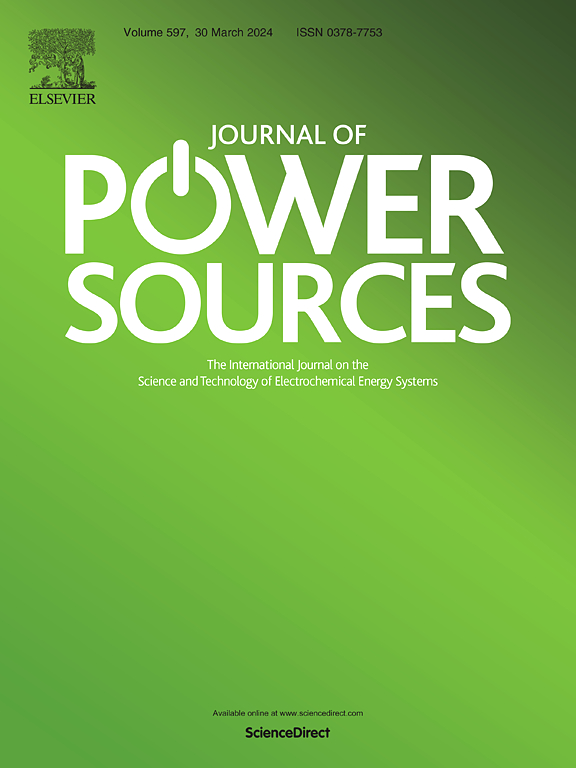纱球状石墨烯微球涂层隔膜设计可提高锂-S 电池的电化学性能
IF 8.1
2区 工程技术
Q1 CHEMISTRY, PHYSICAL
引用次数: 0
摘要
锂硫电池(LSB)具有高能量密度和理论容量,是传统锂离子(Li-ion)电池的理想替代品。然而,硫利用率低、多硫化锂(LiPSs)溶解度高以及容量衰减快等问题阻碍了它们的实际应用。本研究介绍了一种创新的电池配置,即使用涂有还原氧化石墨烯/碳纳米管(rGO/CNT)微球的隔板。涂有还原氧化石墨烯/碳纳米管的分离器旨在增强电子传递,将锂离子电池限制在阴极区域内,并减少其向阳极的迁移。特别是,采用 rGO/CNT 改性隔膜的 LSB 电池的初始容量高达 1482 mAh g-1,而且容量衰减率低,每个周期仅为 0.09%。高导电性的 rGO/CNT 涂层隔膜即使在高速率下也能提高活性材料的利用率,从而在 4C 时产生 824 mAh g-1 的显著容量。此外,在 4.8 mg cm-2 的高硫负荷下,rGO/CNT 改性隔膜显示出 895 mAh g-1 的惊人容量和长期循环性能。结果表明,rGO/CNT 涂层隔膜可显著提高硫的再利用率,减少容量衰减,并改善 LSB 的电化学稳定性。这种配置简化了制造工艺,为 LSB 的实际应用提供了可行的解决方案。本文章由计算机程序翻译,如有差异,请以英文原文为准。
A yarn-ball-shaped graphene microsphere-coated separator design for enhanced electrochemical performance in Li-S batteries
Lithium-sulfur batteries (LSBs) present a promising alternative to conventional lithium-ion (Li-ion) batteries due to their high energy density and theoretical capacity. However, their practical application is hindered by issues such as poor sulfur utilization, highly soluble lithium polysulfides (LiPSs), and rapid capacity decay. This study introduces an innovative cell configuration using a separator coated with reduced graphene oxide/carbon nanotube (rGO/CNT) microspheres. The rGO/CNT-coated separator aims to enhance electron transfer, confine LiPSs within the cathode region, and mitigate their migration to the anode. In particular, the LSB cell with an rGO/CNT-modified separator delivers an impressive initial capacity of 1482 mAh g−1 and demonstrates a low capacity decay rate of 0.09% per cycle. The highly conductive rGO/CNT-coated separator enhances active material utilization even at high rates, resulting in a significant capacity of 824 mAh g−1 at 4C. Furthermore, the rGO/CNT-modified separator shows an impressive capacity of 895 mAh g−1 under high sulfur loading of 4.8 mg cm−2 with long-term cycling performance. The results demonstrate that the rGO/CNT-coated separator significantly enhances sulfur reutilization, reduces capacity decay, and improves the electrochemical stability of LSBs. This configuration simplifies the manufacturing process and offers a viable solution for the practical application of LSBs.
求助全文
通过发布文献求助,成功后即可免费获取论文全文。
去求助
来源期刊

Journal of Power Sources
工程技术-电化学
CiteScore
16.40
自引率
6.50%
发文量
1249
审稿时长
36 days
期刊介绍:
The Journal of Power Sources is a publication catering to researchers and technologists interested in various aspects of the science, technology, and applications of electrochemical power sources. It covers original research and reviews on primary and secondary batteries, fuel cells, supercapacitors, and photo-electrochemical cells.
Topics considered include the research, development and applications of nanomaterials and novel componentry for these devices. Examples of applications of these electrochemical power sources include:
• Portable electronics
• Electric and Hybrid Electric Vehicles
• Uninterruptible Power Supply (UPS) systems
• Storage of renewable energy
• Satellites and deep space probes
• Boats and ships, drones and aircrafts
• Wearable energy storage systems
 求助内容:
求助内容: 应助结果提醒方式:
应助结果提醒方式:


